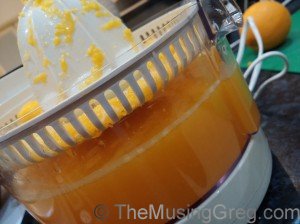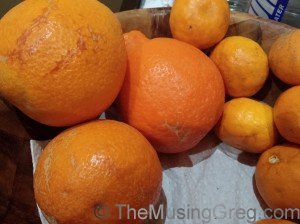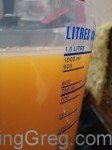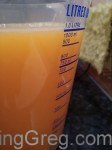
I’ve always been a fan of home-grown produce and supporting local producers whenever possible, and around this time of year for the last couple we’ve bought a few boxes of citrus from Fresh Citrus Direct. They’re a family citrus farm in the SA Riverland who sell their produce direct to the public rather than being forced to dance to the supermarkets’ tune where in most cases the supplier bears the cost of their ‘low’ prices to the customer. Some of our friends at church have property on the Murray and have had to dig up perfectly good orange trees because they can’t compete with the cheap imports from overseas. So I’m keen to support the producers who are left.

Our last order we bought Tangelos, Navels, Mandarins and managed to score a few Blood Oranges. The Tangelos in particular are just so juicy! I’d never tried Blood Oranges before, and apart from looking like half a raspberry inside, have an interesting berry-type tang to them!
Recently Fresh Citrus Direct put on a special on juicing oranges recently, so immediately I started considering how much juice you’d get from a single orange to determine the economics of squeezing your own orange juice. I should preface this by stating that my buying decisions are not based on purely economic grounds, as I know it sometimes costs more to do things properly. Nonetheless on this premise I was curious about the economics of the question.
Naturally I turned to the net to find my answers, but the information I found online was inadequate on several fronts:
- Data varied wildly from site to site – the general consensus seemed to be that an orange weighs about 200g, and about 60-100g of this is juice, but this was by no means all of the sites.
- Most sites were based on information from overseas.
- None mentioned the variety of orange to have any idea if it correlated to what I would be getting.
- Those sites which did provide a juice figure provided it in grams, not in millilitres, and as I buy juice by the litre, not by the kilogram, the comparison ultimately had to be made in liquid measure. I figured it would be safe to assume 1g=1ml (given orange juice is mainly water), but I wanted to be sure.
As I tend to, I decided to find out myself and share my results with others who may be interested, so I took the plunge and bought the biggest box they had in order to get the best value for money. This was a 20kg box shipped to our door for $40 (normally $50). The variety was Hutton and they arrived a couple of days after ordering.
Methodology

Initially I picked five oranges at random. I weighed the empty juice holder (230g) as well as the empty pulp tray (92g) which sat on top of the juice holder on a set of digital scales. This then was the method I used for each orange:
- Weigh orange
- Cut in half and re-weigh (to work out how much juice weight is lost when cutting it)
- Squeeze as much juice as possible from both halves
- Weigh the juiced skins (net (skin + remaining pulp) weight)
- Weigh the juice holder and subtract the previous reading (net juice weight)
- Weigh the pulp holder and subtract the previous reading (net pulp weight)
- Add an error check to ensure no misreadings (post-cut weight – skin – juice – pulp, should be only a couple of grams (tolerance of the scales))
- Calculate what percentage of the orange was juice (juice weight / pre-cut orange weight). I did consider adding the amount lost in cutting but most people would lose this amount anyway, and in the end this typically only accounted for about 0.5%, which was far less than the variation in yield from orange to orange.
After I did the initial five and reviewed the results, I tested four more. These were chosen more carefully to ensure a range of different sizes, including what was clearly orange the largest of the lot (#9).

 Original measure of 1L = 997g
Original measure of 1L = 997g
Finally I weighed 1 litre of juice (as best I could measure it from the bottom of the meniscus on a plastic measuring jug. It weighed 997g. When I added 3g extra juice weight to make it 1kg the line was still on the 1L mark, though higher up. I will assume 1L=1Kg.
Results
| Orange # | Weight pre-cut | Weight post-cut | Skin weight | Juice weight | Pulp weight | Error | % Juice |
|---|---|---|---|---|---|---|---|
| 1 | 222 | 221 | 87 | 119 (349-230) | 13 (105-92) | 2 | 53.6% |
| 2 | 192 | 192 | 73 | 107 (456-349) | 12 (117-105) | 0 | 55.7% |
| 3 | 239 | 238 | 90 | 138 (594-456) | 8 (125-117) | 2 | 57.7% |
| 4 | 175 | 175 | 72 | 85 (679-594) | 17 (141-125) | 1 | 48.6% |
| 5 | 290 | 289 | 111 | 166 (845-679) | 7 (148-141) | 5 | 57.2% |
| 6 | 203 | 202 | 69 | 122 (471-349) | 13 (598-585) | -2 | 60.1% |
| 7 | 177 | 177 | 69 | 100 (571-471) | 7 (605-598) | 1 | 56.5% |
| 8 | 235 | 234 | 85 | 138 (709-571) | 12 (617-605) | -1 | 59.0% |
| 9 | 339 | 338 | 172 | 140 (849-709) | 24 (641-617) | 2 | 41.4% |
Analysis of results
There were several interesting things to note about this:
- The median juice yield from the Hutton oranges sampled was 56.5%. The average yield after discarding the top and bottom two scores (more likely to be anomalous) was 56.15%. So 56% yield is a good figure to base one’s estimations on.
- Orange size is no direct indication of how juicy its contents will be, but average sized oranges are a bit more likely to have better yields than the extremes. Note the following:
- The largest of the lot had the lowest yield; it had a very thick skin and one end looked like it was sprouting.
- The smallest orange had the second-lowest yield.
- The median weight of all the oranges was 222g. The three juiciest oranges had weights of 203, 235 and 239g respectively with an average weight of 226g, yet the orange which actually weighed 222g had a yield of just 53.6%, below both the average and median yields.
- 1L of orange juice weighs 1kg.
- You lose about 1ml of juice when you cut an orange (above table shows 0-1g lost, and above equation states 1ml=1g)
Conclusion
So to answer the original question – is it economical to squeeze your own juice? Evidently the answer to this will correlate directly to the purchase cost of your fruit, but here’s how it worked out for me:
- If yield=56.5%, 20kg of fruit * 0.565 = 11.3kg of juice
- 11.3kg of juice = 11.3L of juice
- Given $40 bought me those 20kg of oranges, it also bought me 11.3L of juice
- Cost of 1L of juice = $40/11.3L = $3.54/L
So freshly squeezed orange juice cost me $3.54 per litre.
That means a normal 2L carton would cost $7.08, plus the time (and minimal electricity) to juice the oranges. From memory most cartons of fresh juice in the supermarket are around the $4-$5 mark for TWO litres ($2-$2.50/L), so to make fresh squeezed juice economical, you’d want to be paying no more than $1/kg for juicing oranges. With the above yields, the juice would work out to about $1.80/L, or $3.60 for a 2L carton.
So economically, does it stack up for me? Not at $2/kg. It tastes nice for sure but it’s not enough of a difference to justify paying a 50% premium as well as having to stand there for 45 minutes every couple of days cutting, juicing and dicing the skins (for better composting) to get a couple of litres of juice. There are certainly other benefits (health, sociological and so on) but this was an experiment in the economics and on that score it doesn’t stack up. I daresay Fresh Citrus Direct are having to jack the price of the fruit up to cover the cost of the ‘free’ shipping. It’d be interesting to know what they’d sell at the ‘orchid door’ for.
This experiment is in no way a negative reflection on Fresh Citrus Direct or any other producer, and as stated there are definitely other considerations to make when choosing a produce supplier – top quality, supporting local producers, keeping the money in Australia, organic produce (in some cases). For these reasons I’ll continue to support Fresh Citrus Direct and other similar industries and hope you will too, but for me I’ll stick to buying fruit for eating.
The main take-home from this is that if you’re considering squeezing your own oranges and your fruit is representative of what I used, you can expect to get about 565ml of juice per kg of oranges you purchase. Work on that and you should be able to determine if it’s cost-effective for you.
Looked at the blog in the context of Mildura juice orange prices offered this year [Australia All Over_ talkback, ABC 25 Nov 2015] at $125/ton, down from $250 ton last year. Based on the blog, call it an raw material input cost of $0.50/L last year & $0.25 /L this year.
Also looked at SENSE report from Europe on not from concentrate [NFC] orange juice lifecycle inputs. There is a substantial discrepancy between the oranges per litre input in that report, but as it was modelled on a different narrative, have to discount it for this purpose.
Depending on retail average pricing recovery, at $2.50 /L; it would suggest that -say- 20% is actual orange juice.
Is this a free trade agreement issue? or the blissfully ignorant supermarket customer influence on the retail megalopolies share holder value?
Yep I’m not surprised the price in Australia has come down so much with so much competition from overseas. Even Crusta juice which used to be 100% fresh is now a mix of ‘imported concentrate and locally fresh squeezed’, something I only noticed on the label after my tastebuds told me something was different. However if that’s the raw price it’s definitely odd that the retail price is that high; there must be a lot of cost being accrued along the supply chain!
Seems a bit late in the day now but a UK comparison for anyone reading in future. Cheap concentrate is 65p/litre, “Not from Concentrate” can be anywhere from £1/litre (Lidl) upto £2.50/l for Tropicana/Tesco Finest and the like.
A net of Oranges varies: 93p/kg (Lidl £1.39 for 1.5kg), £1.50/kg (Tesco 30p/200g ish Orange). I find Lidl doctor their food less for show (ie looks rougher in the shop, not glossy, but means it has less toxins added). So I compare based on the 93p/kg. Maybe these a smaller than average oranges, around 8 per 1.5kg bag so 187g each. Perhaps matching the above consequently the yield is a little lower, around 800ml per net. This gives me a yield of 53% and a price of £1.75/l well below the price of the premium pure juices (which I think the product compares to in quality). I buy a mix of the 99p/l juice and Oranges (more real Oranges in winter when I need the Vit C). I also keep a lot more pulp in my squeezed juice, I think this keeps the fibre levels up so that the fructose content is less of an issue.
Hi Ant,
Thanks for your comment, it was good to note your 53% yield is similar to the average I got of 56%. It demonstrates that even across different varieties and countries that mid 50’s% is a reasonable ballpark figure to work on.
Cheers,
Greg
Very useful information for a piece of work. I was more interested in the weight and capacity than the prices.
Glad it was helpful Korsi! Take care.
Greg
Great Post!
I had the same idea, so i went to look if someone else have done it before me.
I would do exactly the same thing!
But i believe in your conclusions, and here in brazil, it compensates to buy orange and squeeze it because the price per kg of orange (there is no specification about the type/breed/branch) is 1,50 R$(reais) and the juice in bottles of 1L cost 6R$.
Thanks Greg!
I too tried to find this type of thing but couldn’t, hence this post! Glad it was helpful. Yes I’m sure in Brazil it would definitely be worth your while squeezing it yourself – it used to be that way too in Australia, but no longer, ironically because of the amount of oranges available here from Brazil!
There’s nothing like fresh squeezed, so enjoy the fresh produce Guilherme!
Cheers,
Greg
There’s nothing like fresh squeezed, so enjoy the fresh produce Guilherme!
absolutely true – not even remotely similar – that for me is the main consideration
but , if you wanted to complete this analysis, one should consider/compare the price of a 200ml fresh juice from one of those “just juice” places – which will turn out ca. 4 times more expensive than doing at home….
Ezio
Interesting analysis Ezio, yes there are definitely more considerations than cost!
~ Greg